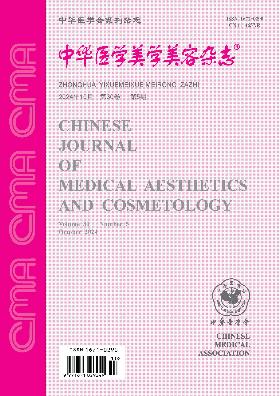Changes of macrophages phenotype markers in fibrous capsules around silicone implants
引用次数: 0
Abstract
Objective To study the temporal distribution of macrophage and its phenotype markers in fibrous capsules around silicone implants. Methods Thirty rats were randomly divided into five groups: days 1, 3, 7, 14 and 35. Silicone prostheses (10 ml) were implanted subcutaneously into backs of rats. On each indicated day, the tissue specimens were collected, fixed in 4% paraformaldehyde for 24 hours and embedded in paraffin. Immunofluorescence was used to detect temporal distribution of M1/M2 macrophages. Results The number of CD68+ macrophages at day 1 (65.8±12.9) was smaller than that at day 3 (102.8±14.5, P<0.05) and day 7 (116.8±14.2, P<0.05); and the number of CD68+ macrophages at day 7 was larger than that at day 14 (56.8±12.9, P<0.05) and day 35 (21.40±6.35, P<0.05); the proportion of iNOS+ CD68+ M1 cells at day 1 and day 3 was 0.48±0.13, 0.60±0.13, respectively, and they were higher than that at day 7 (0.21±0.03, P<0.05), day 14 (0.21±0.03, P<0.05) and day 35 (0.17±0.04, P<0.05); the proportions of CD206+ CD68+ M2 cells at day 1, day 3, day 7, day 14, day 35 were 0.70±0.06, 0.60±0.07, 0.70±0.08, 0.67±0.02 and 0.60±0.06, respectively. Conclusions After the implantation of silicone prostheses, M1 cells increase in early stages and M2 cells maintain in high level throughout the experiment period. Key words: Macrophages; Silica gel; Prosthesis implantation; Implant capsular contracture; Rats硅胶植入物周围纤维囊巨噬细胞表型标志物的变化
目的研究硅胶植入物周围纤维囊巨噬细胞的时间分布及其表型标志物。方法30只大鼠随机分为5组:第1、3、7、14和35天。将硅胶假体(10ml)皮下植入大鼠背部。在每个指定的日子,收集组织标本,在4%多聚甲醛中固定24小时,并包埋在石蜡中。免疫荧光法检测M1/M2巨噬细胞的时间分布。结果CD68+巨噬细胞在第1天(65.8±12.9)少于第3天(102.8±14.5,P<0.05)和第7天(116.8±14.2,P<0.05);CD68+巨噬细胞在第7天的数量大于第14天(56.8±12.9,P<0.05)和第35天(21.40±6.35,P<0.05);iNOS+CD68+M1细胞在第1天和第3天的比例分别为0.48±0.13、0.60±0.13,高于第7天(0.21±0.03,P<0.05)、第14天(0.211±0.03,P<0.01)和第35天(0.17±0.04,P<0.05);CD206+CD68+M2细胞在第1天、第3天、第7天、第14天和第35天的比例分别为0.70±0.06、0.60±0.07、0.70±0.08、0.67±0.02和0.60±0.06。结论硅胶假体植入后,M1细胞在早期增加,M2细胞在整个实验期间保持高水平。关键词:巨噬细胞;硅胶;假体植入;种植体包膜挛缩;大鼠
本文章由计算机程序翻译,如有差异,请以英文原文为准。
求助全文
约1分钟内获得全文
求助全文
来源期刊
自引率
0.00%
发文量
4641
期刊介绍:
"Chinese Journal of Medical Aesthetics and Cosmetology" is a high-end academic journal focusing on the basic theoretical research and clinical application of medical aesthetics and cosmetology. In March 2002, it was included in the statistical source journals of Chinese scientific and technological papers of the Ministry of Science and Technology, and has been included in the full-text retrieval system of "China Journal Network", "Chinese Academic Journals (CD-ROM Edition)" and "China Academic Journals Comprehensive Evaluation Database". Publishes research and applications in cosmetic surgery, cosmetic dermatology, cosmetic dentistry, cosmetic internal medicine, physical cosmetology, drug cosmetology, traditional Chinese medicine cosmetology and beauty care. Columns include: clinical treatises, experimental research, medical aesthetics, experience summaries, case reports, technological innovations, reviews, lectures, etc.

 求助内容:
求助内容: 应助结果提醒方式:
应助结果提醒方式:


